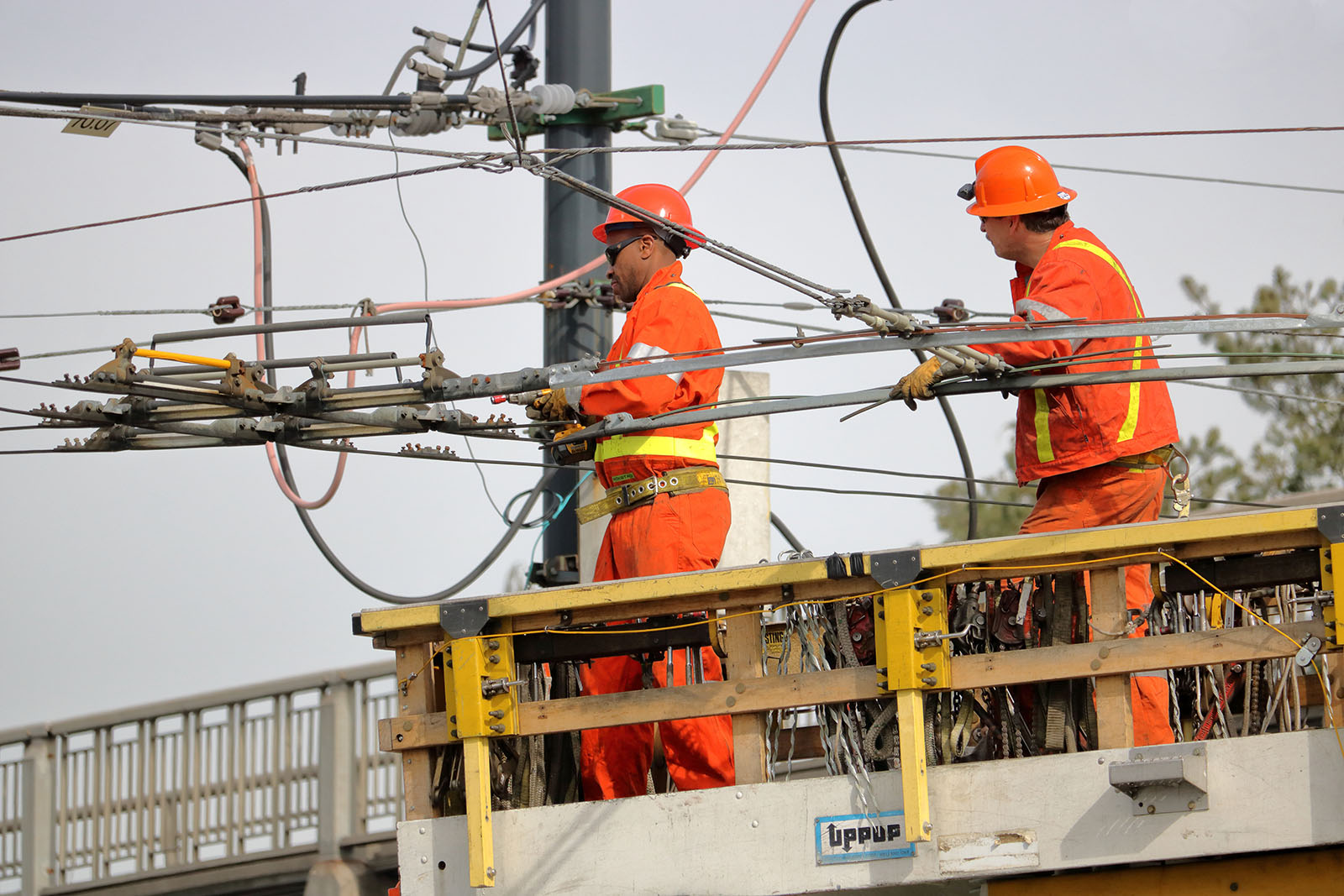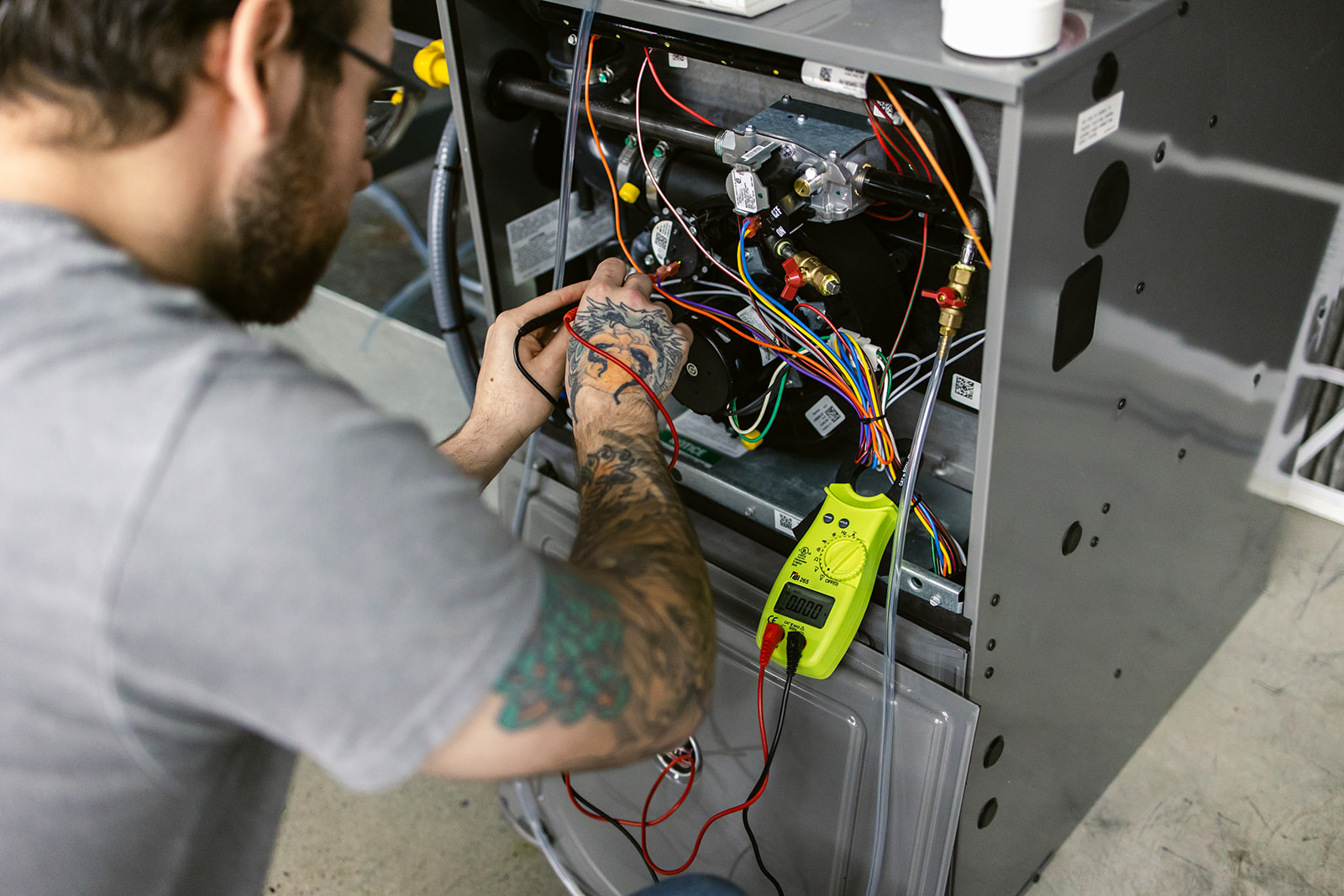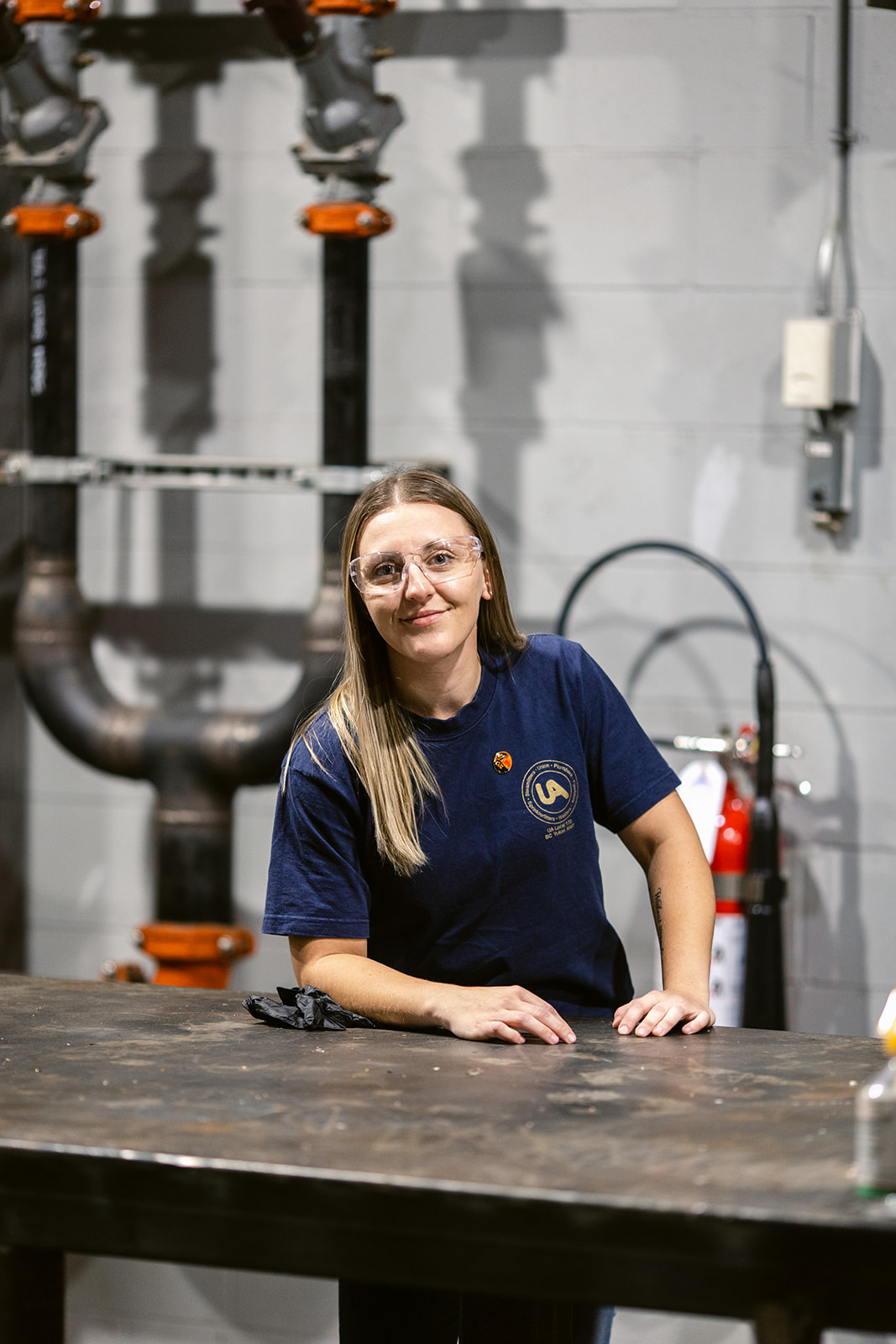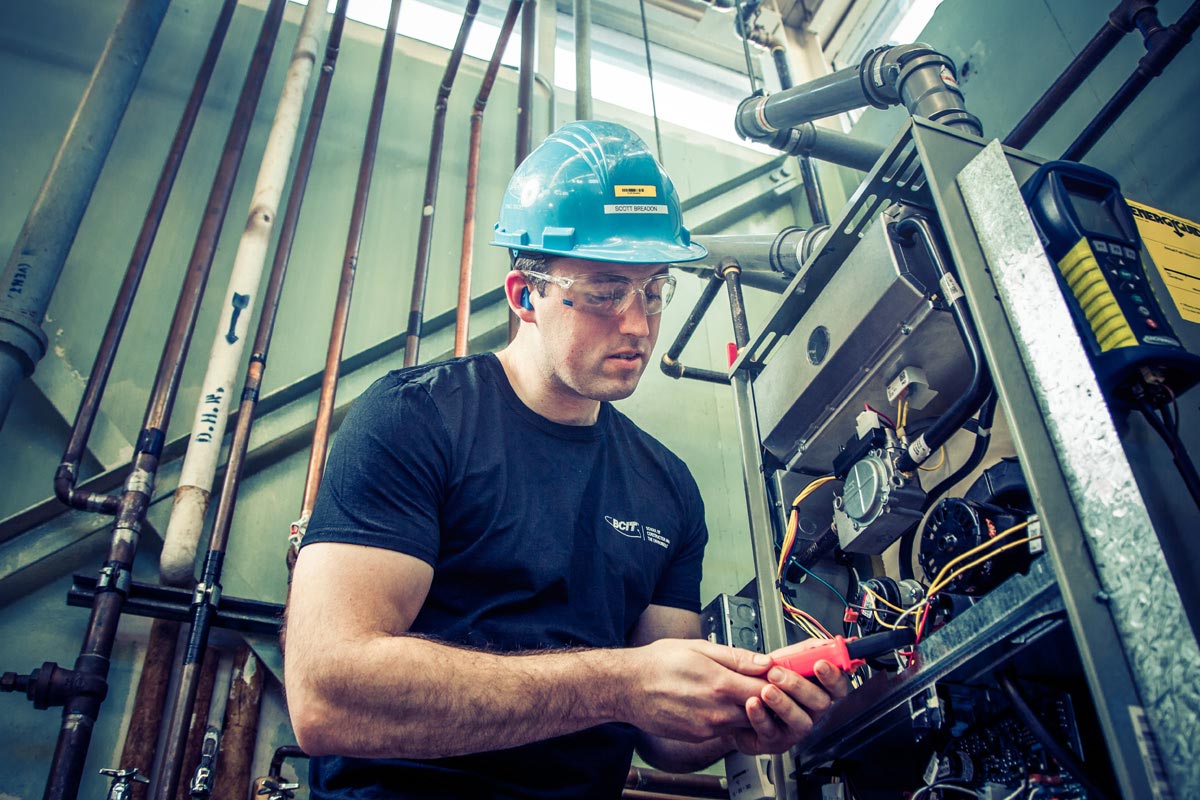Instrumentation and Control Technician
Instrumentation &
Control Technician

- How to consult manufacturer manuals, circuit diagrams and blueprints
- How to test and maintain instruments used for measuring and controlling flow, level, pressure, temperature, chemical composition and other variables
- How to calibrate components and instruments according to manufacturer specifications
- How to perform scheduled preventive maintenance work and complete test and maintenance reports
- How to install control and measurement instruments on existing and new plant equipment and processes
Instrumentation and Control Technicians understand what all the dials, gauges and measuring devices are on any large piece of machinery, to ensure all runs smoothly.
As an Instrumentation and Control Technician, you’ll use your logical approach to repair, maintain, calibrate, adjust and install the dials, sensors and other instrumentation that measure and control industrial/commercial machinery.
You’ll work anywhere that uses complicated machinery—from pulp and paper plants to power plants, mines, manufacturing companies and health services.
Program Updates
None
Program Information and Resources
Program Information and Resources
Exam Information and Resources
Find exam-related information and resources under each menu item below.
Information:
Information:
Information:
Updates:
December 2023: Program Update (IP Exams aligned to 2020 Red Seal Occupational Standards (RSOS)). A Comparative Analysis detailing changes between the 2013 NOA and 2020 RSOS can be found here.
Information:
Challenge the Trade
Challenge the Trade
If you have significant work experience in a trade but have never been certified in Canada, you may apply to challenge the certification. Learn more about How to Challenge a Skilled Trade.
OR
If you sponsor apprentices but have never been certified in Canada, you may request to supervise and sign-off apprentices when they are ready to be certified. Please contact customer service for more information.
- Critical thinking and troubleshooting
- Analytical instrumentation
- Measuring and indicating devices
- Installation and maintenance of pneumatic, hydraulic, and electronic systems
- Communications, networking and signal transmission systems
To get certified, you will need to sign up for technical training at an approved training provider in addition to on-the-job training.
Visit Trades Training BC and EducationPlannerBC for a comprehensive list of what programs are available in your trade at public and non-public schools.
Sprinkler Fitter
Sprinkler
Fitter

- How to read and interpret drawings, specifications and fire codes
- How to select, measure, cut, ream and thread pipe
- How to join pipes and piping sections using soldering and welding equipment
- How to install valves, alarms, controls and associated equipment
- How to test systems for leaks using air or liquid pressure equipment
Sprinkler Fitters have a real impact on the safety of their communities. They are the tradespeople who make sure all buildings have the proper sprinkler systems in place.
As a Sprinkler Fitter, you’ll be comfortable taking on a role of great responsibility—designing, assembling and installing sprinkler systems.
You’ll apply stringent safety regulations to your work, ensuring each system you install and repair is in top working order. Many systems can be quite complicated, and you’ll be the one who makes sure each one can save buildings and even lives, if needed.
Program Updates:
April 1, 2019: The Harmonized Program is in effect
February 2019: Program Update (Foundation and Level 1 Implementation)
December 2018: Program Update (Cross-program credits)
September 2018: Transition Plan
March 2018: OPSN 2018 004 (Harmonization)
Program Information and Resources
Program Information and Resources
Exam Information and Resources
Find exam-related information and resources under each menu item below.
Updates:
- August 2023: OPSN-2023-009 (Sprinkler Fitter HL2 NFPA Code Book Update)
- January 2020: OPSN 2019 021 (HL1 and HL2 SLE Launch)
Information:
Challenge the Trade
Challenge the Trade
If you have significant work experience in a trade but have never been certified in Canada, you may apply to challenge the certification. Learn more about How to Challenge a Skilled Trade.
OR
If you sponsor apprentices but have never been certified in Canada, you may request to supervise and sign-off apprentices when they are ready to be certified. Please contact customer service for more information.
- WHMIS and WorkSafe BC compliance
- Cutting, brazing, and soldering equipment use
- Project planning according to industry codes, regulations and standards
- Sprinkler components installation
- Water supply and sprinkler systems installation
To get certified, you will need to sign up for technical training at an approved training provider in addition to on-the-job training.
Visit Trades Training BC and EducationPlannerBC for a comprehensive list of what programs are available in your trade at public and non-public schools.
For a list of all approved non-public training providers, visit this page.
Security Systems Technician
Security Systems
Technician

- How to use safe work practices
- How to use hand and power tools
- How to use test instruments, fasteners, sealants and surface fillers
- How to apply codes and regulations
- How to install security systems
Security Systems Technicians take care of the systems that take care of us. They are experts who ensure every system works as intended, with no compromise on safety and security.
As a Security Systems Technician, you’ll draw on your persistent style as you plan, troubleshoot and coordinate the installation, repair and maintenance of electronic security alarm systems.
You'll be comfortable working independently, as you reference each task back to various building codes and regulations, and you’ll anticipate the elements that go into each system as you design it.
The Security Services Act refers to Security Systems Technicians as “Security Alarm Installers.” Most security systems technicians in B.C. require a security licence. For more information about the security industry in B.C., and to explore licensing requirements, please visit Security Program Division’s website.
Program Updates
OPSN 2021-005 CEC version for CofQ exam
Certificate of Qualification (CofQ) Exam Breakdown
Program Information and Resources
Program Information and Resources
Challenge the Trade
Challenge the Trade
If you have significant work experience in a trade but have never been certified in Canada, you may apply to challenge the certification. Learn more about How to Challenge a Skilled Trade.
- Critical thinking
- Coordination and troubleshooting
- Safe work practices
- Electrical theory
- Security system design and installation
To get certified, you will need to sign up for technical training at an approved training provider in addition to on-the-job training.
Visit Trades Training BC and EducationPlannerBC for a comprehensive list of what programs are available in your trade at public and non-public schools.
For a list of all approved non-public training providers, visit this page.
Powerline Technician
Powerline
Technician

- How to install, maintain, troubleshoot and repair electrical distribution and transmission systems
- How to erect and maintain steel, wood or concrete poles, towers and wires
- How to splice, solder and insulate conductors and related wiring to connect power distribution and transmission networks
- How to inspect and test power lines and cables
- How to install and maintain street lighting systems
Powerline Technicians are careful and analytical tradespeople who work with the complex electrical systems that deliver power to our homes and businesses.
As a Powerline Technician, you’ll put your analytical nature to the test—in an essential role that ensures the continued, safe supply of power to our communities.
You'll construct, maintain and repair overhead and underground electrical power transmission and distribution systems. You may work for electric power generation authorities, electrical contractors and public utility commissions.
Technical Training
The classroom is where you learn the technical knowledge to complement your work-based training. Make sure to register as early as possible to secure a seat for technical training with a SkilledTradesBC-designated training provider.
Visit Trades Training BC and EducationPlannerBC to find where this program is being offered across the province.
Program Information and Resources
Program Information and Resources
Exam Information and Resources
Find exam-related information and resources under each menu item below. Looking for more exam tips? Visit the Exam and Study Support page.
- Exam Breakdown
- Acronyms and Formulas
- Code Book required: none
- Exam Breakdown
- Acronyms and Formulas
- Code Book required: none
- To be implemented.
- Red Seal Occupational Standard
- Red Seal Exam Preparation Guide
- Red Seal Exam Breakdown (online)
- Red Seal Exam Breakdown (pdf)
- Code book provided: none
Program and Exam Updates
Powerline Technician is a Skilled Trades Certification trade, also known as a compulsory trade, in British Columbia. This means that to work in this trade, you must be registered as an apprentice, be a certified journeyperson, or have applied as a Trade Qualifier or Uncertified Experienced Worker.
January 2020: OPSN 2020 001 (Harmonization Program Changes)
- August 2024: OPSN 2024 019 (Harmonized Level 1 SLE Launch)
- September 2025: OPSN 2025 019 (Harmonized Level 2 SLE Launch)
- March 2021: Program Update (2018 Red Seal Occupational Standard (RSOS))
- A Comparative Analysis detailing changes between the 2013 National Occupational Analysis (NOA) and 2018 RSOS can be found here.
Challenge the Certification Exam
Challenge the Certification Exam
If you have work experience in the trade but have never been certified in Canada, you may be eligible to challenge the certification exam as a Trade Qualifier to become certified without going through an apprenticeship program.
If you have some practical experience but do not yet qualify for the certification exam, you may be eligible to challenge a level exam to enter the program at the appropriate level.
Check the Program Profile on this page for the available pathway options and eligibility details.
Online Application
Create a SkilledTradesBC Portal account to start your application
Declaration Forms Instructions
A section-by-section guide on how to complete the declaration forms
Employer Declaration
A form for your employer to document and attest to your work experience
Statutory Declaration
A form for you to document and attest to your work experience from self-employment or because a direct supervisor cannot be contacted
- Monitoring and critical thinking
- Safe work practices
- Troubleshooting
- Climbing, hydraulic buckets and rigging equipment
- Electrical systems repair and installation
Interested in this trade? Learn how to start your apprenticeship.
Refrigeration and Air Conditioning Mechanic
Refrigeration and
Air Conditioning Mechanic

- How to read and interpret blueprints, drawings and other specifications
- How to install, troubleshoot and overhaul entire heating, ventilation, air handling, refrigeration and air conditioning systems
- How to repair and replace parts and components for entire refrigeration, air conditioning, ventilation and heat pump systems
- How to measure, cut and connect piping
- How to prepare work estimates, work orders and inspection sheets
Refrigeration and Air Conditioning Mechanics (RACM) are naturally logical and persistent, which serves them well as they fix heating, ventilation, air handling, refrigeration and air conditioning systems.
As a Refrigeration and Air Conditioning Mechanic, you’ll install, maintain, and repair residential central air conditioning systems, commercial and industrial refrigeration and air conditioning systems, and combined heating, ventilation and cooling systems.
This will require you to draw from your agile and independent nature, as you’re quick to spring into action and figure out the issues at hand.
Technical Training
The classroom is where you learn the technical knowledge to complement your work-based training. Make sure to register as early as possible to secure a seat for technical training with a SkilledTradesBC-designated training provider.
Visit Trades Training BC and EducationPlannerBC to find where this program is being offered across the province.
Program Information and Resources
Program Information and Resources
Exam Information and Resources
Find exam-related information and resources under each menu item below. Looking for more exam tips? Visit the Exam and Study Support page.
Code Book required: none
Code Book required: none
Code Book required: none
Red Seal Exam Breakdown (online)
Red Seal Exam Breakdown (pdf)
Code Book provided: none
Program and Exam Updates
Refrigeration and Air Conditioning Mechanic is a Skilled Trades Certification trade, also known as a compulsory trade, in British Columbia. This means that to work in this trade, you must be registered as an apprentice, be a certified journeyperson, or have applied as a Trade Qualifier or Uncertified Experienced Worker.
April 2025: OPSN 2025 007 (New Cross Program Credits)
January 2023: For information regarding Year 4 of transition, please see the Transition Update or the Transition Plan for more details. Apprentices who have completed Current Level 2 (CL2) or Current Level 3 (CL3) should contact their Apprenticeship Advisor to discuss options for addressing gaps in their training before taking their next level of technical training.
February 2019: OPSN-2019-001 Program changes
Please be aware that changes have been made to the Gasfitter - Class B program, please view OPSN 2018 002.1 for details.
October 2021: OPSN 2021 014 (HL1 SLE launch)
August 2022: OPSN-2022-018 (HL2 & HL3 SLE Launch)
Challenge the Certification Exam
Challenge the Certification Exam
If you have work experience in the trade but have never been certified in Canada, you may be eligible to challenge the certification exam as a Trade Qualifier to become certified without going through an apprenticeship program.
If you have some practical experience but do not yet qualify for the certification exam, you may be eligible to challenge a level exam to enter the program at the appropriate level.
Check the Program Profile on this page for the available pathway options and eligibility details.
Online Application
Create a SkilledTradesBC Portal account to start your application
Declaration Forms Instructions
A section-by-section guide on how to complete the declaration forms
Employer Declaration
A form for your employer to document and attest to your work experience
Statutory Declaration
A form for you to document and attest to your work experience from self-employment or because a direct supervisor cannot be contacted
- Troubleshooting
- Fundamentals of refrigeration
- Electrical components and safety
- Refrigeration and air conditioning installation
- Air conditioning servicing
Interested in this trade? Learn how to start your apprenticeship.
Locksmith
Locksmith

- How to interpret blueprints
- How to apply codes and regulations
- How to use key-cutting and welding tools and equipment
- How to create keys and install and repair locks
- How to install electrical components, master key systems and security hardware
Locksmiths are security experts who build, install, repair and maintain the complex and fascinating systems we use to start our cars, lock our homes and protect our valuable possessions.
As a Locksmith, you’re a highly inquisitive and precise professional who never shies away from a complex challenge.
Due to your persistent and logical nature, you’ll greatly enjoy working on all sorts of security components. You’ll not only cut keys, but also repair, service and install various control systems.
Above all, you’ll take pride in a career that helps people feel more secure.
Most locksmiths working in B.C. require a security licence. For more information about the security industry in B.C., and to explore licensing requirements, please visit Security Program Division’s website.
Program Updates
Exam Breakdowns
Program Information
Program Information
Challenge the Trade
Challenge the Trade
If you have significant work experience in a trade but have never been certified in Canada, you may apply to challenge the certification. Learn more about How to Challenge a Skilled Trade.
- Customer service
- Communication
- Use of tools and equipment
- Creating keys and repairing locks
- Installing security systems
Steamfitter/Pipefitter
Steamfitter/
Pipefitter

- How to cut openings for pipes in walls, floors and ceilings
- How to select the type and size of pipe required for different types of content
- How to measure, cut, bend, weld, braze, cement, solder and thread pipes
- How to test existing piping systems for leaks
- How to clean and maintain pipe units and fittings
Steamfitter/Pipefitters are logical, hands-on tradespeople who enjoy shaping pipes and installing them for use in a range of systems—from high-pressure water to fuels, cooling solutions and more.
As a Steamfitter/Pipefitter, you’ll need to use your math skills and agility to figure out how to design, assemble, install, maintain, troubleshoot and repair complex pipe systems.
You’ll need to be comfortable working independently as you analyze each situation. You’ll also need to be creative with how you design your systems and master heating and bending pipes at very high temperatures.
Skilled Trades Certification Updates:
Steamfitter/Pipefitter is a Skilled Trades Certification trade, also known as a compulsory trade, in British Columbia. This means that to work in this trade, you must be registered as an apprentice, be a certified journeyperson, or have applied as a Trade Qualifier or Uncertified Experienced Worker.
Program Updates
April 2024: Transition Update (Year 6)
April 2023: Transition Update (Year 5)
May 2022: Transition Update (Year 4)
May 2022: Transition Plan (Version 2)
Harmonization Progress
Level 1 - Harmonized*
Level 2 - Harmonized*
Level 3 - Harmonized*
Level 4 - Harmonized*
*Harmonized = Program stream with re-aligned content beginning in April 2019
**Current = Program stream for apprentices who've completed level 1 training before April 2019
If you are unclear as to what program you are registered in, or unclear as to which program you should be following, please contact us.
Harmonized Program Information and Resources
Harmonized Program Information and Resources
In effect starting April 2019, as per Transition Plan
Please be aware that changes have been made to the Gasfitter - Class B program, please view OPSN 2018 002.1 for details.
Exam Information and Resources
Find exam-related information and resources under each menu item below.
Updates:
- October 2019: OPSN 2019 016 (Harmonized Level 1 SLE Launch)
Information:
- Exam Breakdown
- Code Book required: none
Updates:
- February 2022: OPSN 2022 002 (Harmonized Level 2 SLE Launch)
Information:
- Exam Breakdown
- Code Book required: Gas Code CSA B149.1-15 or CSA B149.1-20
Updates:
- May 2022: OPSN 2022 010 (Harmonized Level 3 SLE Launch)
Information:
- Exam Breakdown
- Code Book required: Gas Code CSA B149.1-15 or CSA B149.1-20
Updates
- March 2025: Program Update (IP Exams aligned to the 2022 Red Seal Occupational Standards (RSOS)). A Comparative Analysis detailing changes between the 2015 NOA and the 2022 RSOS can be found here.
- October 2018: Program Update (RSOS 2015)
Exam Information
- Red Seal Occupational Standard 2022
- Red Seal Exam Preparation Guide
- Red Seal Exam Breakdown (online)
- Red Seal Exam Breakdown (pdf)
- Code Book provided: None
Challenge the Trade
Challenge the Trade
If you have significant work experience in a trade but have never been certified in Canada, you may apply to challenge the certification. Learn more about How to Challenge a Skilled Trade.
- Critical thinking
- Layout and fabrication
- Piping component assembly
- Water supply management
- Hydronic, natural gas and propane system installation
To get certified, you will need to sign up for technical training at an approved training provider in addition to on-the-job training.
Visit Trades Training BC and EducationPlannerBC for a comprehensive list of what programs are available in your trade at public and non-public schools.
For a list of all approved non-public training providers, visit this page.
Electrician Endorsement: Marine
Electrician Endorsement:
Marine

- How to install marine wiring
- How to install and maintain power generation components
- How to install and maintain power distribution components
- How to install and maintain shipboard systems and controls
- How to test and troubleshoot
Marine Electricians enjoy the challenge of managing electrical installation, maintenance and repairs in a marine environment—keeping our ships functioning safely and efficiently.
As a Marine Electrician, you’ll bring your resourceful approach to a unique environment.
Every day, you’ll take a hands-on and careful approach to the complex systems that run our ships. You’ll ensure safe distribution of electrical power by installing electrical components, interpreting drawings and applying codes and regulations.
Program Updates
- None
- OPSN Archives
Program Information and Resources
Program Information and Resources
Exam Information and Resources
Endorsement Exam
Updates:
- None
Information:
- Exam Breakdown
- Code Books provided: IEEE-45-2002, TP 127E 2008
Challenge the Trade
Challenge the Trade
If you have significant work experience in a trade but have never been certified in Canada, you may apply to challenge the certification. Learn more about How to Challenge a Skilled Trade.
- Critical thinking
- Troubleshooting
- Judgement and decision-making
- Quality control analysis
- Installation and maintenance
To get certified, you will need to sign up for technical training at an approved training provider in addition to on-the-job training.
Visit Trades Training BC and EducationPlannerBC for a comprehensive list of what programs are available in your trade at public and non-public schools.
Electrician, Industrial
Industrial Electrician

- How to read and interpret drawings, blueprints and electrical code specifications
- How to install electrical components
- How to replace or repair electrical components
- How to keep maintenance records
- How to test electrical equipment for current, voltage and resistance
Industrial Electricians work behind-the-scenes to ensure the safe and efficient operation of a wide range of sites—from mines to shipyards and factories.
As an Industrial Electrician, you’ll inspect, test and repair industrial equipment and electrical systems.
You’ll be inspecting, installing, maintaining and repairing high-voltage industrial equipment and electrical controls at shipyards, factories, and other industrial sites. You’ll have an analytical skillset and good dexterity to ensure you can safely work in a physical and alert way.
Technical Training
The classroom is where you learn the technical knowledge to complement your work-based training. Make sure to register as early as possible to secure a seat for technical training with a SkilledTradesBC-designated training provider.
Visit Trades Training BC and EducationPlannerBC to find where this program is being offered across the province.
Harmonized Program Information and Resources
Harmonized Program Information and Resources
Exam Information and Resources
Find exam-related information and resources under each menu item below. Looking for more exam tips? Visit the Exam and Study Support page.
- Exam Breakdown
- Acronyms
- Formulas
- Code Book required: Canadian Electrical Code 2021 or 2024
- Exam Breakdown
- Acronyms
- Formulas
- Code Book required: Canadian Electrical Code 2021 or 2024
- Exam Breakdown
- Acronyms
- Formulas
- Code Book required: Canadian Electrical Code 2021 or 2024
- Red Seal Occupational Standard 2021
- Red Seal Exam Preparation Guide
- Red Seal Exam Breakdown (pdf)
- Acronym Sheet
- Formula Sheet
- Code book provided: Canadian Electrical Code 2021 (until May 31, 2025)
- Code book provided: Canadian Electrical Code 2024 (as of June 1, 2025)
Logbook, Sign-off Form, and Evidence Guides
Program and Exam Updates
Industrial Electrician is a Skilled Trades Certification trade, also known as a compulsory trade, in British Columbia. This means that to work in this trade, you must be registered as an apprentice, be a certified journeyperson, or have applied as a Trade Qualifier or Uncertified Experienced Worker.
August 2022: Program Update
March 2021: Transition Plan (Version 3)
March 2021: Revised Competency Migration charts
For more information on the Marine Endorsement please refer to the Marine Electrician - Endorsement Program page.
December 2019: OPSN 2019 019 (HL1 and HL2 SLE launch)
February 2025: OPSN 2025 001 (Electrician CEC Announcement)
June 2023: OPSN 2023 007 (HL3 SLE Launch)
October 2023: Program Update (IP Exams aligned to 2021 Red Seal Occupational Standards (RSOS)). A Comparative Analysis detailing changes between the 2016 RSOS and 2021 RSOS can be found here.
March 2025: OPSN 2025 003 (Electrician CEC IPSE Announcement)
Challenge the Certification Exam
Challenge the Certification Exam
If you have work experience in the trade but have never been certified in Canada, you may be eligible to challenge the certification exam as a Trade Qualifier to become certified without going through an apprenticeship program.
If you have some practical experience but do not yet qualify for the certification exam, you may be eligible to challenge a level exam to enter the program at the appropriate level.
Check the Program Profile on this page for the available pathway options and eligibility details.
Online Application
Create a SkilledTradesBC Portal account to start your application
Declaration Forms Instructions
A section-by-section guide on how to complete the declaration forms
Employer Declaration
A form for your employer to document and attest to your work experience
Statutory Declaration
A form for you to document and attest to your work experience from self-employment or because a direct supervisor cannot be contacted
- Critical thinking
- Troubleshooting
- Judgement and decision-making
- Quality control analysis
- Installation and maintenance
Interested in this trade? Learn how to start your apprenticeship.
Gasfitter - Class B
Gasfitter
Class B

- How to measure and mark reference points for gas installations
- How to install and maintain gas meters, regulators and lines
- How to install, maintain and service gas heating units and their components
- How to repair and service gas appliances and related equipment
- How to test for and deal with gas leaks
Gasfitters are careful people who enjoy a physical workplace and function well under pressure. They are very precise, as they oversee the gas systems that heat and power our homes and businesses.
As a Gasfitter – Class B, you’ll use your strong math skills and thorough approach to install, repair and maintain propane and natural gas products found in homes and buildings with safety as top of mind.
You may find yourself inside a building or outside, working on a range of tasks that ensure the proper use of gas.
Technical Training
The classroom is where you learn the technical knowledge to complement your work-based training. Make sure to register as early as possible to secure a seat for technical training with a SkilledTradesBC-designated training provider.
Visit Trades Training BC and EducationPlannerBC to find where this program is being offered across the province.
New Red Seal Program Information
New Red Seal Program Information
Implementation Date: January 1, 2025
Exam Information and Resources
Find exam-related information and resources under each menu item below. Looking for more exam tips? Visit the Exam and Study Support page.
- National Occupational Analysis
- Gasfitter - Class B Exam Self-Assessment
- Red Seal Exam Breakdown
- Formula Sheet
- Code Book provided:
- B149.1 Natural Gas and Propane Installation Code
- B149.2 Propane Storage and Handling Code
Program and Exam Updates
Note: SkilledTradesBC is responsible for administering the apprenticeship for Gasfitter – Class B Certificate of Qualification with Red Seal Endorsement. Technical Safety BC is responsible for overseeing the safe installation and operation of technical systems and equipment through Gas Certification. Please refer to the Technical Safety BC website for information on its gas certification exam requirements.
Trade workers and their employers are responsible for ensuring they hold the necessary licenses or credentials to meet all applicable regulatory requirements.
In British Columbia, Gasfitter – Class B is a Skilled Trades Certification trade, administered by SkilledTradesBC. Trade workers must also be certified by Technical Safety BC to work in the trade, and more information on that certification is available here on the Technical Safety BC website.
Skilled Trades Certification, also known as compulsory trades, requires tradespeople working in the trade to be either a registered apprentice with SkilledTradesBC or a certified journeyperson.
To be considered a certified journeyperson, you must hold one of the following qualifications:
A Gasfitter – Class B Certificate of Qualification issued by SkilledTradesBC (either B.C. or with Red Seal endorsement) or other Canadian jurisdictional authorities; or
A Class B Gas Fitter Certificate of Qualification issued by Technical Safety BC, obtained by successfully passing a full-scope technical exam.
If you have any questions about Skilled Trades Certification requirements, please complete this Contact form and our Advisors will get in touch with you.
April 2025: OPSN 2025 004 updated Instructor requirements for instructors delivering Red Seal Gasfitter - Class B content.
November 2024: The Red Seal Gasfitter - Class B program will be implemented on January 1, 2025. Please see OPSN 2024 026.
April 2022: Program Update (Level 1 SLE Code Book Compliance)
December 2019: OPSN 2019 022 (Level 1 SLE Launch)
November 2024: Program Update (IP Exams aligned to 2014 Gasfitter - Class B NOA)
Challenge the Certification Exam
Challenge the Certification Exam
If you have work experience in the trade but have never been certified in Canada, you may be eligible to challenge the certification exam as a Trade Qualifier to become certified without going through an apprenticeship program.
If you have some practical experience but do not yet qualify for the certification exam, you may be eligible to challenge a level exam to enter the program at the appropriate level.
Check the Program Profile on this page for the available pathway options and eligibility details.
Online Application
Create a SkilledTradesBC Portal account to start your application
Declaration Forms Instructions
A section-by-section guide on how to complete the declaration forms
Employer Declaration
A form for your employer to document and attest to your work experience
Statutory Declaration
A form for you to document and attest to your work experience from self-employment or because a direct supervisor cannot be contacted
- Monitoring and quality control
- Operation of power tools and equipment
- Fuel systems and gas equipment
- Venting and air supply
- Controls and safeguards
Interested in this trade? Learn how to start your apprenticeship.
